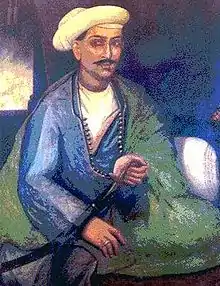Zamindars of Bihar
The Zamindars of Bihar were the autonomous and semi-autonomous rulers and administrators of the Mughal subah of Bihar and later during British rule.[1] The zamindars of Bihar were numerous and could be divided into small, medium and large depending on how much land they controlled.[2] Within Bihar, the zamindars had both economic and military power. Each zamindari would have their own standing army which was typically composed of their own clansmen.[3]
The majority of these zamindars usually belonged to upper-caste Hindu communities such as Rajputs, Maithil Brahmins, Bhumihars and also Yadavs.[4]

Relations with the Mughals
Mughal rule in Bihar was characterised as turbulent and volatile as many of the region's zamindars made continuous efforts to defy the imperial authority.[5] Generally, the Mughals had great difficulty in subduing the chiefs of Bihar.[6] Many of the major zamindaris and chieftaincies in the suba of Bihar were located in hilly and forested areas which proved beneficial in terms of dealing with potential conflicts. These zamindars had an obligation to pay tribute to the Mughal authorities but rebellions were common and in many instances the army would have to be sent in to Bihar to subdue the rebellious zamindar.[6] A notable instance of this occurred in 1503 when Raja Sangram Singh of Kharagpur Raj rebelled and was subsequently killed in battle. His son was then converted to Islam and became a staunch ally of the Mughals.Gop zamindars of Tintanga karari Bhagalpur headed by Santlal gop revolted against pindaris in Bihar and Mughals in return Bahadur Shah Zafar gifted him 5000 acres of land and made his son Maheshwari prashad Yadav jagirdar of Naugachia janpadh This Zamindars also revolted against the britishers and stop paying giving taxes to East India Company therefore britisher started occuping on lands of Mughals.Gop zamindars of Tintanga karari Bhagalpur [7]
The nineteenth century British civil servant, John Beames noted about Mughal-ruled Bihar that "everyone who was powerful enough to rob the state or his neighbours, robbed to his hearts content".[8] Zamindars refusing to pay the state and gathering forces to attack neighbouring zamindars was a common practice in Bihar during this period.[8]
This attitude to authority continued into the period when the Nawabs of Bengal and Murshidabad became the nominal governors of Bihar. Although Bihar had the potential to provide a large amount of revenue and tax, records show that the Nawabs were unable to extract any money from the chiefs of Bihar until 1748. And even following this, the amount gained was very low. This was again due to the rebellious nature of the zamindars who were "continually in arms".[9]
1781 rebellion against the British
After the collapse of the Mughals, the British East India Company held sway over much of South Asia.[10][11] In 1781, their control of Bihar was disturbed when some of the zamindars (especially those in South Bihar) started to rise in revolt following the rebellion of Chait Singh, the Maharaja of Benares state.[11] Among the rebels in Bihar, were Raja Narain Singh of Seris-Kutumba, Akbar Ali of Narhat Samoy and Fateh Bahadur Sahi of Huseypur. Among the motivations for the rebellion was the reluctance of these zamindars to provide revenue to the British. However, many zamindars in Bihar were also loyal to the British and refused to take part.[11] Eventually the British were able to subdue the rebellion without too much trouble.
Abolition

Following independence in 1947, there was large-scale support in Bihar for the abolition of zamindari especially among peasants, agricultural labourers and the urban middle-class who stood to gain the most from this.[12] This culminated in a large-scale movement in support of abolition led by lower-castes. The Bhumihar zamindars realised that abolition was going to occur and planned for abolition to be on their terms.[12] However, the Rajput-Kayastha zamindars strongly resisted this. Thus, in Bihar the resistance for Zamindari abolition came not only from the landlords but also from the Rajput-Kayastha lobby who followed delaying tactics in the passage of Zamindari Abolition Bill. The only exception to this was K B Sahay. Eventually, the Bihar Abolition of Zamindaris Act was passed in 1949.[12]
Notable zamindari estates
- Banaili
- Bettiah Raj
- Cheros of Palamu
- Gop Estate Naugachia Tintanga
- Gidhaur chieftaincy
- Deo Raj
- Dighwara Raj
- Dumraon Raj
- Hathwa Raj
- Jagdishpur estate
- Jharia Raj
- Kharagpur Raj
- Ledo Estate
- Lohandi Raj
- Nagvanshis of Chotanagpur
- Mohrampur- Patna Jagir
- Raj Darbhanga
- Ramgarh Raj
- Sonbarsa Raj
- Tajpur Raj
- Tekari Raj
See also
References
- Ahmad Raza Khan (1982). "Perquisites And Non-Agrarian Sources Of Income Of The Zamindars Of Suba Bihar 17th And 18th Centuries". Proceedings of the Indian History Congress. 43: 290–295. JSTOR 44141239.
- Lata Singh (2012). Popular Translations of Nationalism: Bihar, 1920-1922. Primus Books. pp. 5–7. ISBN 978-93-80607-13-9.
- Tahir Hussain Ansari (20 June 2019). Mughal Administration and the Zamindars of Bihar. Taylor & Francis. p. 2. ISBN 978-1-00-065152-2.
- Jha, Hetukar (1 October 1977). "Lower-Caste Peasants and Upper-Caste Zamindars in Bihar (1921-1925): An Analysis of Sanskritization and Contradiction between the Two Groups". The Indian Economic and Social History Review. 14 (4): 549–559. doi:10.1177/001946467701400404. S2CID 143558861.
- Kumkum Chatterjee (1996). Merchants, Politics, and Society in Early Modern India: Bihar, 1733-1820. BRILL. pp. 31–32. ISBN 90-04-10303-1.
- TH Ansari (2010). "The Nature of Relationship between the Chieftains of Bihar and the Mughal Empire". Proceedings of the Indian History Congress. 71: 319–326. JSTOR 44147499.
- Tahir H Ansari (2001). "Kharagpur Raj Under Akbar". Proceedings of the Indian History Congress. 62: 1096–1097. JSTOR 44155867.
- Gyan Prakash (30 October 2003). Bonded Histories: Genealogies of Labor Servitude in Colonial India. Cambridge University Press. pp. 88–90. ISBN 978-0-521-52658-6.
- P. J. Marshall (2 November 2006). Bengal: The British Bridgehead: Eastern India 1740-1828. Cambridge University Press. pp. 58–60. ISBN 978-0-521-02822-6.
- P. J. Marshall (2 November 2006). Bengal: The British Bridgehead: Eastern India 1740-1828. Cambridge University Press. pp. 95–. ISBN 978-0-521-02822-6.
- Paramita Maharatna (2007). "Explaining Chait Singh's Revolt in Bihar (1781): The Role of the Refractory Bihar Zamindars". Proceedings of the Indian History Congress. 68: 565–572. JSTOR 44147866.
- Mitra Subrata K; Bhattacharyya Harihar (27 February 2018). Politics And Governance In Indian States: Bihar, West Bengal And Tripura. World Scientific Publishing Company. pp. 155–158. ISBN 978-981-320-824-7.
